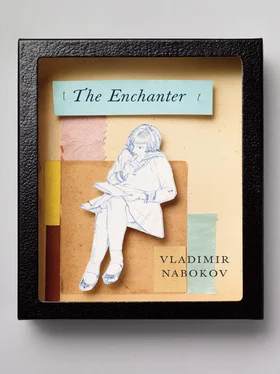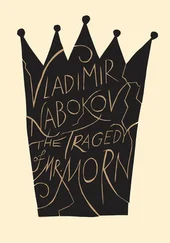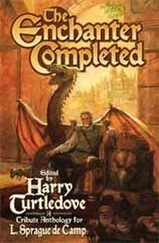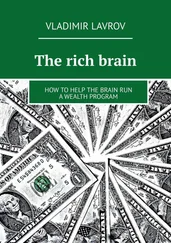In agonizing moments of introspection he recognizes the beast and tries to will it away. Ingeniously appropriate images recur in bestial counterpoint—hyenas in every hygiene; onanistic tentacles; the lupine leer in place of the intended smile; the licking of chops at the thought of his defenseless, sleeping prey; the whole leitmotif of the Wolf about to devour his Red Riding Hood, complete with its eerie final echo. This dark beast within him, this bête noire of his, must always be construed as the protagonist’s implicit self-perception, and, in his rational moments, it is what the Enchanter fears most; thus, catching himself in an absentminded smile, he posits, with pathetic, flimsy hope, that “only humans are capable of absentmindedness” and that therefore he too might after all be human.
The stratification of the story is most striking in its double- and triple-bottomed imagery. It is true, in a sense, that some delicate passages are more explicit than elsewhere in Nabokov. But at other moments the sexual undercurrent is no more than the glinting facet of a simile or the momentary derailment of a train of thought headed for a quite different destination. Multiple levels and senses, as is known, occur often in Nabokov. Yet the line he treads here is razor thin, and the virtuosity consists in a deliberate vagueness of verbal and visual elements whose sum is a complex, otherwise undefinable, but totally precise unit of communication.
An analogous kind of ambiguity, whose purpose and synthesis are again the exact expression of a complex concept, is at times employed to convey the concurrent—and conflicting—thoughts racing through the protagonist’s brain. As a limpid instance of what I mean, let me cite one such passage, whose paradoxes, at first sight, challenge reader and translator alike, but, when approached without selectively closing the switch on tracks of thought parallel to what at first seems the main line, again reward one with a crystalline whole that is greater than the sum of its parts; the openness of receptivity required here, which would perhaps represent overkill in dealing with more conventional writing, is akin to that which a sensitive ear will apply to the counterpoint of Bach or the thematic texture of Wagner, or which a stubborn eye will force upon a recalcitrant brain when their possessor perceives that the same elements of a tricky design can simultaneously yield, say, an ape peering wistfully out of its cage and a beach ball bobbing, hopelessly out of reach, amid the reflections of a sunset on the repetitious ripples of an azure sea.
The protagonist, rather than face his odious nuptial obligations, has gone roaming in the night. He has considered various alternatives of disposing of his newly acquired, already superfluous spouse, who is promisingly ill, but every moment of whose existence keeps him from the girl he craves. He has pondered poison, presumably entered a pharmacy, perhaps made a purchase. On his return he sees a strip of light under the door of the “dear departed” and says to himself “Charlatans… We’ll have to stick to the original version.” The concurrent ideas here can be listed thus:
1. He is disappointed that she has not gone to sleep.
2. He had half-consciously been equating sleep with death.
3. Our seeing her, through his eyes, as the “dear departed” connotes his sarcastic reaction to her being
a. awake
b. alive.
4. Or the term “dear departed” signifies that, in his mind, she is already dead or as good as dead.
5. He must now either satisfy his unappetizing bride or find a plausible excuse to say good night and go to bed (the “original version”).
6. His access to the girl remains as problematic as ever.
7. The “charlatans” are
a. the pharmacists whose potion he did not buy;
b. the pharmacists whose potion he did buy but did not use;
c. the pharmacists whose potion his obsessed imagination has meanwhile administered, expecting to find the woman dead, equating, as we have seen, wakefulness with life (for “pharmacists” read the whole establishment of forensic medicine that has somehow let him down);
d. the pangs of conscience and/or fear that have made him discard the idea of poison and/or murder in general; or
e. the hope against hope that he has succeeded in simply willing her demise.
8. All of the above merge in the kaleidoscope of a mad mind.
Did the man actually enter the pharmacy? Here, as elsewhere, my translatorial ethics would prohibit adding to Father’s text to make things more explicit in English than they are in Russian. The text’s multilevel, pleasingly elliptical form is an integral part of its character. If VN had wanted to be more specific here, he would have done so in the original.
Time and place are purposely left imprecise in the story, which is essentially timeless and placeless. One might presume that the 1930s are nearly over, and, as Nabokov later confirmed, [19]that we are in Paris, and then en route to the south of France. There is also a brief detour to a small city not very far from the capital. The only character mentioned by name in the text [20]is the least important one: the female servant, in that provincial city, who helps the ill-fated child pack and shoos away the chicks as the car, containing protagonist and prey united at last, speeds away.
I shall leave to the studious—among whom exist some superbly sensitive readers of Nabokov—the detailed identification and the documentation of themes and levels (straight narrative, tricky metaphor, romantic poetry, sexuality, fairy-tale sublimation, mathematics, conscience, compassion, fear of being strung up by the heels), as well as the search for hidden parallels with The Song of Igor’s Campaign or Moby Dick . Father would have put Freudians on guard against rejoicing at the ephemeral mention of a sister, the girl’s curious regression into infancy at the end, or the elaborate walking stick (which is unabashedly and entertainingly phallic but, on a totally distinct plane, visually evocative as well of the appetizing, “valuable” objects—another example is the rare, blank-faced watch—with which Nabokov sometimes liked to endow his characters).
Certain other compressed images and locutions should, possibly, be explained, since it would be a pity if they were wasted. Here are a few “special” examples, given, unlike those singled out above, in proper order.
The “black salad devouring a green rabbit” ( this page; one of a number (see below) of visual aberrations that, on one level, give the story a surreal, enchanted aura while, on another, describing with utmost economy and directness how a character’s perception of reality is momentarily distorted by a state of being (in this case, the protagonist’s overpowering, thwarted, barely concealed excitement).
The “little Japanese steps” ( this page): many if not all readers must have seen, on the big screen or the little one, or at the opera, or perhaps in the real Orient, the geisha-style walk—short, mincing steps on high platform sandals—to which Nabokov likens the girl’s progress on skates whose wheels refuse to roll on the gravel.
A potentially more cryptic passage is that of the “strange, nailless finger” scrawled on the fence ( this page). Here, again, deliberate ambiguity, concurrent images and ideas, and multiple levels of interpretation are at play. To spell this one out: The “definite goal” that emerges from a substratum of the man’s brain is access to the girl via marriage to the mother. The imagined graffito on the fence is a hybrid of the forefinger pointing the way on old-fashioned signs and of some joker’s phallic doodle that the digit’s stylized, nailless shape simultaneously suggests to a mind bent, basically, on depravity, but not devoid of self-reproaching flashes of objectivity. This ambiguous finger simultaneously indicates, in the fleeting image, the path of courtship (of the mother), the secret parts of the yearned-for girl, and the protagonist’s own vulgarity that no amount of rationalization can explain away.
Читать дальше










